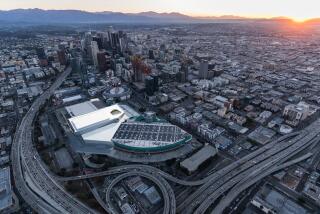Southern Spain Jumping Toward 21st Century : World’s fair: Andalusia and the city of Seville are undergoing the greatest face lift in their history.
- Share via
SEVILLE, Spain — Four bridges span the indolent Guadalquivir River here today, legacy of 20 centuries of settlement that began in Roman times. Over the next three years, seven new bridges will be built across the muddy river that is Seville’s trademark and its lifeblood.
Storied Seville, one giant detour now, is in the throes of the greatest face lift in its history. Dazzling modernization for the regional capital is the cornerstone of a regional development scheme that will yank flamenco-and-sherry Andalusia pell-mell into the 21st Century. Amid great expectation, and some disquiet, the era of the superlative has come to laggard southern Spain.
The catalyst is a 1992 world’s fair, Expo ‘92, that will be this century’s last and, yes, history’s biggest.
The Spanish government, with a big financial assist from the European Community, is investing $7 billion to bring the rickety Andalusian infrastructure up to continental standards. A self-financing state corporation will spend $800 million to prepare the exhibition site on 538-acre La Cartuja Island in the middle of the river.
Hundreds of millions more will come from 170 exhibitors at Expo itself--101 countries have signed up so far--and from off-site private investors hoping to cash in with everything from souvenir shops to luxury hotels.
Roads, a high-speed railroad, expanded regional airports, a refurbished port, and high-tech telecommunications are all wending their way from drawing boards to the streets and countryside of Spain’s most populous region.
In the Spanish matrix, Andalusia, with 17% of the national population but only 12% of national income, is renowned more for graceful languor than dynamism. What is being called Europe’s most ambitious project of the ‘90s is expected to generate 200,000 jobs for a region whose unemployment is higher than in the rest of Spain.
Even in its early earthmoving, pipe-laying stages, regional development is having great impact: Spain will grow economically 5% this year; Andalusia 6.8%.
By the time Expo’s 176-night run ends on the 500th anniversary of Christopher Columbus’ arrival in the New World, Oct. 12, 1992, it will have reached into the lives of all 6.8 million Andalusians.
Seville, now wed mostly to tourism, will get its first ring road, and be linked to the rest of Spain by multi-lane expressways for the first time. A bullet train will halve travel time from Madrid to three hours, and passengers will detrain at a spanking new Seville terminal.
Regional airports at Seville, Malaga and Jerez will lose their provincial air. The phones will work.
Such are the promises of officials at the autonomous regional Andalusian government who are overseeing the construction.
“We are providing investment that Andalusia needs in an accelerated form. Necessary improvements that might be scheduled over 15 or 20 years will instead be accomplished in three,” said Jaime Montaner, public works minister for the regional government who is overseeing the construction.
The overall project is enormous, though, and amid traffic-jammed, construction-everywhere inconvenience, nerves are already jangling.
“Seville is uncomfortable, but everybody in Seville wants Expo. We all understand that it is worth suffering now for the benefits that will come later,” Montaner said.
With the fair pledged to open Easter Monday, April 20, 1992, construction deadlines are inelastic. A road finished months late may benefit Andalusia as much in the long run but in the interim may imperil Expo’s success and embarrass Spain with the whole world watching.
Spain will mark Columbus’ anniversary as its own coming of age in a uniting Europe. In addition to Expo, it will sponsor the 1992 Summer Olympics in Barcelona, a European Cultural Year in Madrid, and a major exhibit in Toledo celebrating Spain’s Jewish and Muslim heritage.
Planners expect that 18 million visitors will come to Seville’s Expo, and pay an average daily admission price of about $20 to see a fair conceived as a cross between a Disney extravaganza and a classical exhibition.
Montaner promises that Andalusia will not disappoint them.
“There is no cause for alarm. On the contrary, things are moving well. Everything is on schedule. It’s a great challenge, but we’ll be ready,” he told a visitor to his office in the cobblestones-and-tourists old quarter of a city that became one of the richest in the world when it enjoyed a 16th-Century monopoly of trade with what is now Latin America.
Amid the bulldozers and tumbled red earth on the Expo island, Jacinto Pellon, the bearded engineer and weekend sailor who is chief executive of the Seville Universal Exposition 1992, is equally upbeat.
“On site, we are on time. We are pushing the exhibitors to begin their own construction next spring,” he said, describing his project as “something like Epcot, but a bit more serious, and with a lot of entertainment; rock to ballet to symphonic music to experimental theater.”
The U.S. Information Agency will sponsor the $20-million American pavilion.
Columbus is the star of what is technically a Universal Exposition in the tradition of the only other three of the breed since World War II: Brussels ‘58, Montreal ‘67, and Osaka ’70.
It was in the 15th-Century Carthusian monastery of Santa Maria de las Cuevas on La Cartuja Island that Columbus planned his journey. He lived behind the thick monastery walls between trips and was buried there for a time.
The monastery itself, later converted to a ceramics factory that operated until 1982, is being restored, nave to frescoes, as the symbol of an exhibition that will also feature the replica of the 15th-Century port of Seville whence the Admiral of the Ocean Sea ventured west with the Nina, the Pinta and the Santa Maria.
Exposition chief Pellon says Expo will draw on past international extravaganzas such as the Osaka fair and the Los Angeles Olympics, but with an important difference. After Expo ends, the island and many of its structures will become a center for university instruction and corporate research and development.
Another of the lasting benefits will be construction of the the first full-blown opera house for a city to which opera is no stranger: “Barber of Seville” to “Carmen” to “Fidelio” and “Don Giovanni.”
More to Read
Sign up for Essential California
The most important California stories and recommendations in your inbox every morning.
You may occasionally receive promotional content from the Los Angeles Times.













